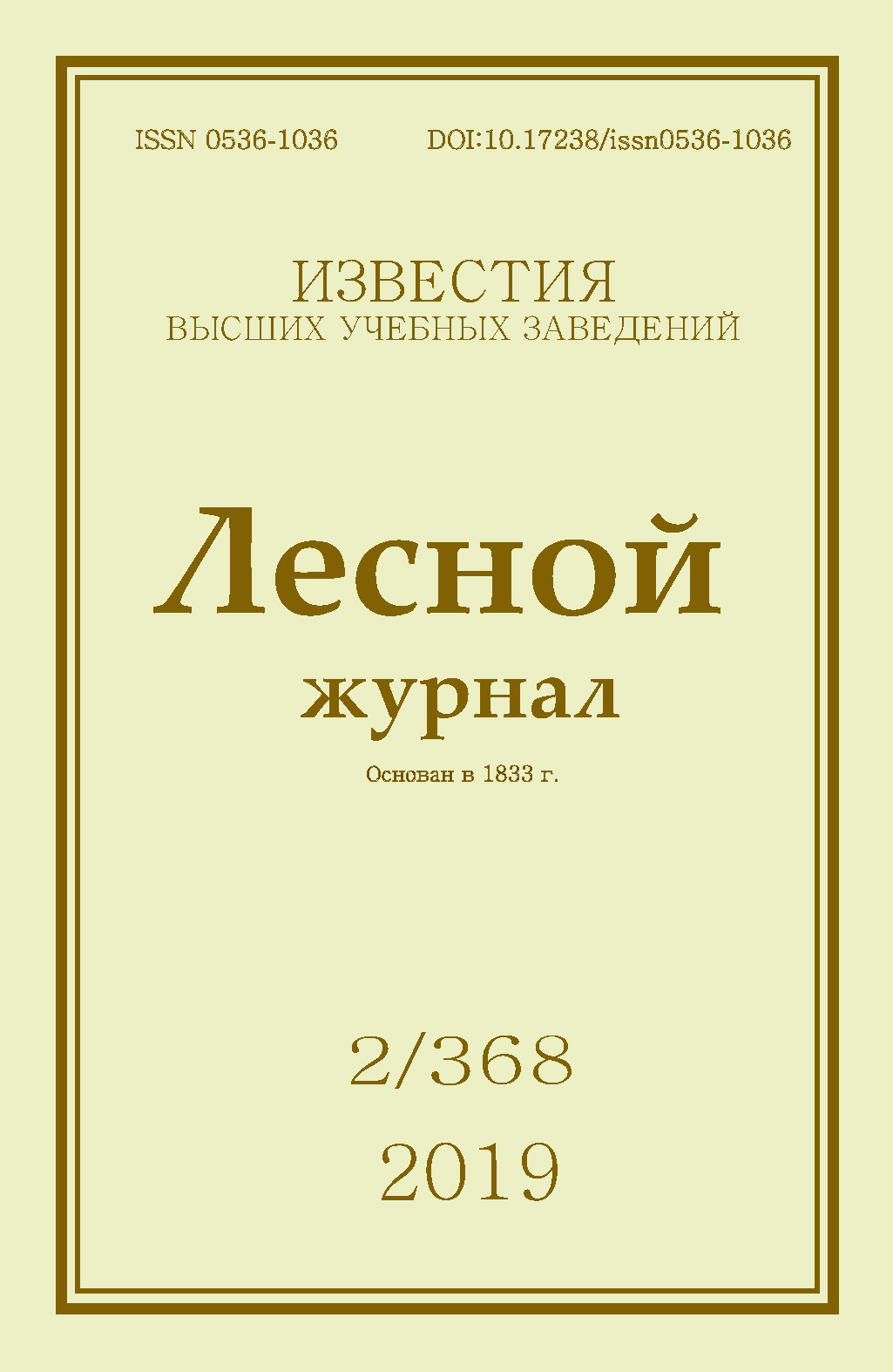Improving the Feeder’s Working Capacity of Timber Processing Equipment
DOI:
https://doi.org/10.17238/issn0536-1036.2019.2.102Keywords:
frictional and mechanical contact, feeding rollers, working capacity, friction, coupling, wearing out, geometrical shape, tribological parameters, loadAbstract
The working capacity of the logging and wood processing equipment feeding mechanisms is determined by the achievable coupling of the roller’s working elements with the movable blanks. The coupling stability depends significantly on the geometry specified in the design and implemented in manufacturing and physicochemical properties of the materials of tenons that capture, hold and continuously move the blanks into the processing zone. During operation, the geometrical parameters of tenons are changing due to wearing out, which is a result of a complex set of mechanical, chemical, thermal and other influences that accompany friction and deformation interaction of working elements of feeders and movable wood. Worn down tenons do not provide reliable movement of a blank, due to its slippage, which causes quality reduction of final products and leads to intensification of the cutting tool wearing out. At the same time the features of influence of tenon geometrical form on the mating forces of feeding rollers with movable blanks in conditions of development of the tribotechnical characteristics, which provide their working capacity, are not studied sufficiently for the practical use. Therefore, the research purpose is to clarify the conditions of friction-mechanical interaction of working elements of rollers with wood and to identify patterns of wearing out of tenon working surfaces, which allows theoretically substantiate their rational geometrical shape and requirements for the physicochemical characteristics of recommended materials. The acting load’s principles realized in the zone of contact of the metal surfaces of tenons with wood at displacement of blanks are considered for these purposes. The process of the force interaction change of tenons with blanks is shown beginning with the moment of contact of a certain tenon until it leaves the coupling. Its analysis showed that already at the beginning of the contact the shock bending load begins to act on the top of a tenon. The load in case of peak values often leads to wearing out by crumbling sufficiently large microvolumes of the feeding tenons. The probability of development of such fracture pattern is the greatest with insufficient strength of the using material and pre-sence of structural defects, especially unfavorably located microcracks, and the action of dangerous tensile residual stresses. These factors also significantly affect the corrosion-mechanical wearing out of the working surfaces of tenons and their resistance movement in wood. Thus, the main factor of effective transportation of a blank to the processing zone and achievement of high wearing resistance of feeding rollers is optimization the tenon geometry, properties of the assigned materials and technology of strengthening treatment of the concerned details.
For citation: Pamfilov E.A., Pilyushina G.A., Sheveleva E.V., Prozorov Ya.S., Pyrikov P.G. Improving the Feeder’s Working Capacity of Timber Processing Equipment. Lesnoy Zhurnal [Forestry Journal], 2019, no. 2, pp. 102–110. DOI: 10.17238/issn0536-1036.2019.2.102
Downloads
References
Бершадский Л.И. Основы теории структурной приспосабливаемости и переходных состояний трибосистем и ее приложение к задачам повышения надежности зубчатых и червячных передач: дис. … д-ра техн. наук. Киев, 1982. 394 с.
Гороховский К.Ф., Лившиц Н.В. Машины и оборудование лесосечных и лесоскладских работ: учеб. пособие. М.: Экология, 1991. 528 с.
Памфилов Е.А., Пилюшина Г.А. Возможности и перспективные пути повышения работоспособности машин и оборудования лесного комплекса // Лесн. журн. 2013. № 5. С. 129–141. (Изв. высш. учеб. заведений).
Пилюшина Г.А. Повышение работоспособности деталей подающих устройств лесопильного оборудования: дис… канд. техн. наук. Брянск, 2004. 148 с.
Пилюшина Г.А., Памфилов Е.А. Повышение работоспособности лесопильного оборудования // Лесн. журн. 2007. № 4. С. 85–91. (Изв. высш. учеб. заведений).
Пилюшина Г.А., Пыриков П.Г., Рухлядко А.С. Повышение работоспособности рабочих органов оборудования и режущих инструментов для обработки неметаллических материалов // СТИН. 2013. № 2. С. 9–13.
Пилюшина Г.А., Шевелева Е.В. Исследование сцепления фрикционномеханических шиповых перемещающих устройств // Фундаментальные исследования и инновационные технологии в машиностроении: сб. науч. тр. V Междунар. науч. конф., Москва, 8–9 ноября 2017 г. М.: ИМАШ РАН, 2017. С. 211–214.
Characterization of Corrosion Products on Steel Surfaces / ed. By Yo. Waseda, Sh. Suzuki. Berlin: Springer-Verlag Berlin Heidelberg, 2006. 297 p. DOI: 10.1007/978-3-540-35178-8
Darmawan W., Rahayu I.S., Tanaka C., Marchal R. Chemical and Mechanical Wearing of High Speed Steel and Tungsten Carbide Tools by Tropical Woods // Journal of Tropical Forest Science. 2006. Vol. 18, no. 4. Pp. 255–260.
Jellesen M.S. Tribocorrosion Properties of Metallic Materials and Effects of Metal Release: Ph.D. Thesis. Department of Manufacturing Engineering and Management, Technical University of Denmark (DTU), 2007. 74 p.
Mischler S. Triboelectrochemical Techniques and Interpretation Methods in Tribocorrosion: A Comparative Evaluation // Tribology International. 2008. Vol. 41, iss. 7. Pр. 573–583. DOI: 10.1016/j.triboint.2007.11.003
Pamfilov Е.А., Lukashov S.V., Prozorov Ya.S. Mechanochemical Fracture of the Components of Wood-Cutting Equipment // Materials Science. 2014. Vol. 50, iss. 1. Pp. 148–155. DOI: 10.1007/s11003-014-9703-x
Pamfilov E.A., Pilushina G.A., Polosov V.I. Conditions of Maintenance of Stable Frictional Contact of Submitting Rollers Woodworking Machines // Proceedings of BALTTRIB 2007 International Scientific Conference, Kaunas, November 21–23, 2007. Kaunas, 2007. Pp. 67–71.
Pilyushina G.A., Pyrikov P.G., Rukhlyadko A.S. Improving the Performance of Machining Tools for Nonmetallic Materials // Russian Engineering Research. 2013. Vol. 33, no. 9. Pp. 532–535. DOI: 10.3103/S1068798X13090128
Porankiewicz B., Sandak J., Tanaka Ch. Factors Influencing Steel Tool Wear When Milling Wood // Wood Science and Technology. 2005. Vol. 39, iss. 3. Pp. 225–234.
Silman G.I., Pamfilov E.A., Gryadunov S.S., Gruvman A.I. Effect of the Structure of Chromium-Vanadium White Irons on Their Wear Resistance // Metal Science and Heat Treatment. 2007. Vol. 49, no. 7–8. Pp. 405–408. DOI: 10.1007/s11041-007-0076-8
Wood R.J.K. Tribo-Corrosion of Coatings: A Review // Journal of Physics D: Applied Physics. 2007. Vol. 40, no. 18. Pp. 5502–5521. DOI: 10.1088/0022-3727/40/18/S10







